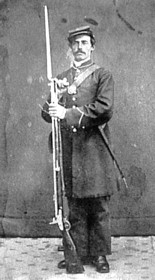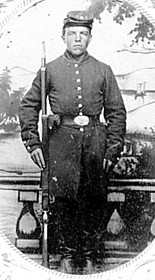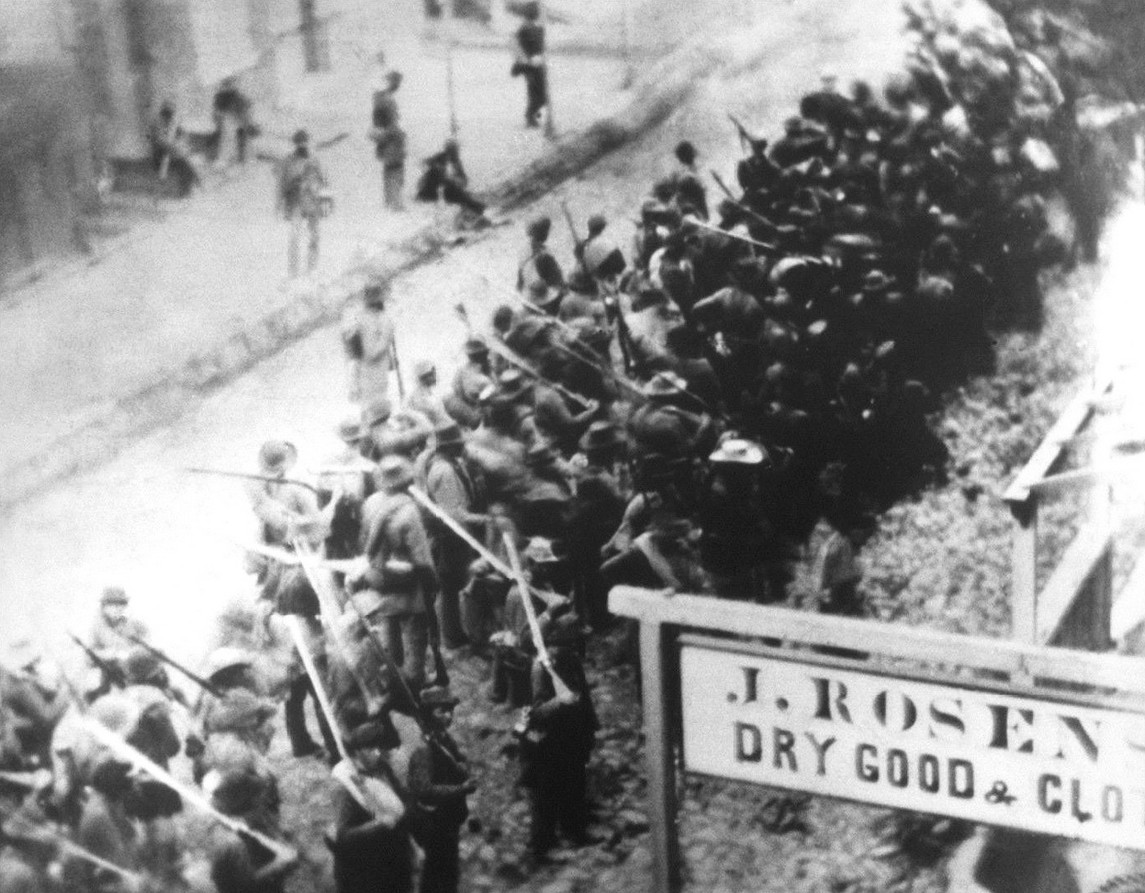|
THE AMERICAN CIVIL WAR SOLDIER : FIREARMS

At the beginning of the American Civil War, firearms of all types were in short supply. Many early volunteers were issued antiquated, imported, and nearly obsolete weapons as
both sides strained to meet the demand for arms. Eventually, however, a few quality types were obtained in large numbers and
became standard issue to the soldiers of both armies.
CIVIL WAR INFANTRY
The basic weapon of an infantry soldier was the single-shot,
muzzle-loading percussion musket. Foremost among these was the Springfield, manufactured at the U.S. Armory in Springfield,
Massachusetts, and at other locations. All were generically referred to as "Springfields" by the troops. By the end of the
war, total production approached 1.5 million weapons. The Springfield had a 39 inch long rifled barrel, and could fire a .58
caliber bullet effectively at targets 500 yards distant. After the Confederate capture of the Federal armory at Harper's Ferry,
Virginia (later West Virginia), more than 64,000 Confederate copies were produced.

A close competitor to the Springfield, and the best of the foreign-made
weapons, was the British Enfield. These were imported by both North and South in numbers exceeding 800,000. The Enfield fired
bullets of .577 caliber the same distance as a Springfield, and the ammunition was interchangeable between the two. Externally,
there were few differences.
Nevertheless, some officers felt a decided bias against the
Enfield. "They are rough, and tear the men's hands to pieces when going through the manual (of arms)" one officer complained.
Ordnance officers noted that the hand-finished parts of an Enfield did not interchange, as did those of a machine-made Springfield.
Col. Joshua Chamberlain, commanding the 20th Maine Regiment, noted the number of abandoned Springfields around his position on Little Round Top after the fighting there on 2 July, 1863, and instructed his men still using Enfields to exchange them for Springfields.

|
| (Library of Congress) |
A variety of other European rifles were used by the infantry
of both sides. Among the most prolific of this "second class" of rifled arms was the Austrian Lorenz. Over 225,000 were purchased
by the Federal government alone. Many of these .54 caliber rifles were rebored to accept the standard .58 caliber ammunition.
LEFT: A Union soldier stands for his portrait
with a Austrian Lorenz Rifle-Musket, one of the many types of weapons imported from Europe by the Union and the Confederacy.
This rifle saw extensive service in both armies and was universally loathed by many of the soldiers who used them.
While rifles were preferred for their long range and accuracy,
many older smooth-bore muskets of foreign and domestic manufacture saw service as well. Chief among these was the 1842 Springfield.
This weapon had a 42 inch long, .69 caliber barrel. It simultaneously fired one solid .69 caliber and three small
buckshot. Produced until 1855 at Springfield, Massachusetts and at Harper's Ferry, Virginia (now West Virginia), 172,000 were
made. Some of these (about 10,000) were later rifled in the pre-war period.
The bulk of these, however, were issued as smoothbores to Civil
War troops. Without the extra range of a rifle, soldiers so armed found themselves handicapped against an enemy armed with
rifles. In his Memoirs, General U. S. Grant observed that, using such an arm, "you might fire at a man all day from
a distance of 125 yards without him ever finding it out." At Gettysburg, one such Federal unit (the 12th N.J.) held its fire
until charging Confederates were within 100 yards and then opened fire, "...giving them volley after volley of buck-and-ball
from our smoothbore muskets, cutting great swaths in their ranks...".
The shot that killed Maj. Gen. John Sedgwick during the Battle of Spotsylvania Court House came from a Whitworth rifle at a distance of more than 500 yards. Sedgwick was the highest-ranking Northern officer
to die on a Civil War battlefield. The identity of the Confederate sharpshooter who fired the fatal shot remains a mystery, although at least five Confederate soldiers later claimed responsibility.
CIVIL WAR CAVALRY
The principal shoulder weapon of the mounted services was a
short-barreled carbine. These were effective out to 200 yards. Numerous designs appeared early in the war, and close to 20
different types were eventually adopted by Federal forces. They ranged from fairly simple single-shot breechloaders using
a paper or linen cartridge and a percussion cap, to complex repeaters firing self-priming metallic cartridges. Calibers ranged
from .44 to .54, and many carbines took specially made cartridges. Resupply of ammunition often proved tedious.

|
| (Library of Congress) |
One mainstay of the cavalry on both sides was the Sharps. In
production since the early 1850's, this .52 caliber arm was already known to be strong and reliable, and about 80,000 were
purchased by the Federals. The Sharps was the primary weapon of General John Buford's division as it delayed the Confederate
infantry advance towards Gettysburg on 1 July, 1863. Even though a single-shot, its breech-loading mechanism allowed a trooper
to get off up to 5 shots per minute, against possibly 3 from a muzzle-loading musket.
RIGHT: A Union soldier poses in a warlike stance with a Model
1861 Springfield Rifle-Musket, one of the most reliable infantry weapons of the war.
As with the Springfield, the Confederates made their own copies
of the Sharps, but demand far outstripped production. Only about 5,000 Confederate or "Richmond" Sharps were made. Of these,
General Robert E. Lee wrote that they were "so defective as to be demoralizing to our men." Southern horsemen had to make
do with captured Yankee breech-loaders, for which ammunition might be hard to come by, or stick with awkward short-barreled
muzzle-loaders, for whom cartridges could be produced locally. A few Southern arsenals, most notably the Richmond Arsenal
in Virginia, the Fayetteville Arsenal in North Carolina and the Cook & Brother Armory of Athens, Georgia, attempted to
manufacture muzzle-loading carbines for Confederate troopers. Production was slow and erratic, and never met the needs of
the men in the field.
If the shortage of good, serviceable single-shot breech-loading
carbines did not vex the Confederate cavalryman, the appearance of reliable repeaters in the hands of his foes must surely
have.
One such weapon was the Spencer, patented in 1860. Available
in .52 caliber, it was capable of sending out seven aimed shots within thirty seconds. The effects of such firepower were
overwhelming to Confederates used to the slower muzzle-loaders. Often, Federals with Spencers fired only one shot together
to simulate a volley of musketry and waited for the Confederates to advance. When they did, the Unionists unleashed the other
six shots in a rapid fusillade of fire that devastated the Southern lines. One Confederate observed, "There's no use fighting
against such guns..." Over 94,000 carbines were acquired for use by Federal forces. None of them were used at Gettysburg,
but the 5th and 7th Michigan regiments of General Custer's brigade were armed with the longer rifle version, and did good
service with them there. One Michigan trooper, Robert Trouax, later distinguished himself with his Spencer rifle at the Rapidan
River, "killing six rebels as they were crossing the river".
Another repeater held in high esteem was the .44 caliber Henry
Rifle. Carrying 16 shots, it too put a Confederate opponent at a severe disadvantage. While only 10,000 Henry Rifles were
made, and only 1,731 purchased by the government, their presence on the battlefield was felt by the Confederates. One of General
William T. Sherman's soldiers stated: "I think the Johnnys are getting rattled; they are afraid of our repeating rifles. They
say we are not fair, that we have guns that we load up on Sunday and shoot all the rest of the week."
The ill-supplied Southern trooper could not hope to match the
firepower of these repeating weapons, for they utilized special copper rim-fire cartridges that were beyond the production
capability of Confederate ordnance. In the case of handguns, though, both sides were more evenly matched. The manufacturing
centers for these weapons were still located in the North, but few designs required the use of special ammunition. Captured
revolvers were much more easily (and hence much more often) turned against their former owners.
The most prolific maker of handguns in the Civil War era was
Samuel Colt. During the conflict his Hartford, Connecticut firm produced nearly 150,000 .44 caliber six-shot revolvers (the
1860 "New Model Army"). The vast majority of them went to the Union war effort, but Colt sold arms to all buyers until a few
days after the firing on Ft. Sumter. These guns were durable and powerful. From 16 yards, a bullet from a Colt Army revolver
penetrated seven white pine boards, each 3/4" thick, separated by one inch of dead space between them. Colt also manufactured
a "Navy" model revolver in .36 caliber. Introduced in 1851, the Navy was widely available in the South, and a favorite arm
of Confederate horsemen. Before the war's end, 185,000 Navy revolvers had been produced.
| Civil War Soldier Firearms, Weapons, Small Arms. |

|
| Common Civil War Soldier Firearms and Rifles. |
(About) Rare photo of Confederate soldiers armed with Pattern 1853 Enfield rifle-musket
as they march through Maryland toward Antietam on September 12, 1862. LOC.gov.
Another major supplier of revolvers to the Federal government
was the firm of E. Remington and Sons, of Ilion, New York. Beginning in 1858, Remington introduced an improved series of simplified
revolver designs that featured a solid frame, which made the arm stronger and cheaper to produce than its primary competitor,
the Colt. The War Department purchased approximately 114,000 .44 and .36 caliber Remington revolvers at $12.00 per gun, while
Colt was still charging $25.00 for their New Model Army.
This considerable difference in price cost Colt's much government
business during the latter half of the war. Less expensive than a Colt, the Remington was an eminently serviceable handgun.
At the close of the conflict, when discharged Federal cavalrymen were given the option to purchase their issue sidearm, more
Remingtons were sold than Colts.
A variety of other firms also supplied revolvers to the Federal
forces in limited numbers. Whitney, Allen, Savage and others provided less than 40,000. Smith and Wesson made small, metallic
cartridge .22 and .32 caliber revolvers during this time, and these were sold in small lots or purchased privately.
Many foreign-made revolvers were imported and used by both sides.
The French Lefaucheux "pin-fire", which took a special .45 caliber cartridge, armed many Federal troops in the Western theater.
The Confederates purchased several thousand 5-shot "Kerr" revolvers, and a number of other types as well. The best-known of
these, however, was the LeMat Revolver. Developed in pre-war New Orleans, Louisiana, by Dr. Alexander LeMat, this pistol fired nine .42 caliber bullets in addition
to a .63 caliber shotgun charge.
Although a colorful pistol, and associated with such personalities
as Confederate generals P.G.T. Beauregard, J.E.B. Stuart, and Captain Henry Wirz, relatively few were manufactured. Production
problems proved difficult to overcome, and less than 3,000 were produced in France and England.
Confederates also made their own revolvers, although in numbers
far short of Federal production. It is estimated that less than 10,000 Confederate handguns were manufactured, mostly in Georgia.
Southern arms-makers were cursed with a lack of proper materials to work with. Steel was not available, and brass and iron
were often substituted. Brass was scarce, and the bells of many Southern churches were donated "for the Cause" and melted
down to supply it. That brass became pistol frames in some Confederate revolvers.
The most successful Confederate revolver maker was the firm
of Griswold and Gunnison. Between July of 1862 and November, 1864, nearly 3,600 pistols were produced in Griswoldville, near
Macon (about 70 miles south of Atlanta). "Griswolds", as they were called, were .36 caliber brass-framed copies of the Colt
Navy. While production totals do not compare favorably with that of the Colt Company in Connecticut, it is interesting to
note the following: The Griswold factory was operated by 24 people, 22 of whom were slaves!
Another Confederate firm, Spiller and Burr, produced a solid-frame
Whitney pattern .36 caliber revolver. They made around 750 brass-framed copies in Atlanta. Production was unbearably slow,
however, and the Confederate government bought the facility and moved it to Macon. There, another 689 guns were completed
before December of 1864.
By December of 1864, arms were no longer in short supply.
The production ability of Northern industry, coupled with massive importations of arms by both sides, led to a surplus of
Civil War-era small arms that existed well into the second decade of the twentieth century. Even now, weapons from the era are occasionally discovered. If you find
one, treat it carefully. The last shot of the Civil War may not yet have been fired. See also Civil War Firearms and Small Arms: The Rifles
and Revolvers and Civil War Weapons, Firearms, and Small Arms.
(Sources listed at bottom of page.)
Recommended Reading:
An Introduction to Civil War Small Arms. Description: Fifty Union and Confederate
muskets, rifles, carbines and pistols are concisely discussed with specifications. Also includes photographs of the ammunition!
The overall format is an introduction to each weapon with basic specifications, several paragraphs of text about development
use and production, a photograph of the weapon, a period photo of a soldier armed with the same, and a photo of the cartridge.
Continued below...
This is repeated for each major weapon. There are also several other general information sections about
various aspects of small arms. (Of considerable use to "wargamers" is a section listing known weapons of MANY regiments; looks
like at least 1,000.)
Recommended Reading:
Civil War Firearms: Their Historical Background and Tactical Use. Description:
The popular Civil War News columnist has written a unique work, combining technical data on each Civil War firearm, an often
surprising treatment of their actual use on the battlefield, and a guide to collecting and firing surviving relics and modern
reproductions. About the Author: Joseph G. Bilby is a popular columnist for the Civil War News and a veteran of the current
69th Regiment.
Recommended Reading: Civil War Collector's Encyclopedia: Arms, Uniforms and Equipment of the Union and
Confederacy. Description: This comprehensive and exhaustive
reference identifies and describes the use and application of more than 800 items. Arranged alphabetically by topic,
subjects range from artillery accouterments and boats to tools and patriotic sheet music. "Everything an interested reader
would want to know . . . A must-have book." — Antiques & Auction News. Over 350 rare illustrations. Continued below...
The
Civil War buff and even serious collector of Civil War arms, uniforms and equipment should purchase the Civil War Collector's
Encyclopedia: Arms, Uniforms And Equipment Of The Union And Confederacy as an indispensable reference and core guide in this
specialized area of military antiques and collectibles with noted authority Francis A. Lord covering almost everything to
do with Civil War memorabilia--from equipment to Union and Confederate uniforms.
Recommended Reading: Warman's Civil War Weapons. Description:
The weapons of the Confederate and Union Armies, a commanding presence 140 years ago, are among today's most revered
collectibles. Warman's Civil War Weapons offers Civil War enthusiasts a listing of more
than 100 weapons and military vehicles, featured in 400 stunning full-color photos, and covers the effectiveness of each
weapon in battle. Continued below...
From the early battles that relied
on muzzleloaded weapons, to the introduction of submarines, handguns, shoulder arms, edged weapons and more, this book chronicles
the history of an innovative age of weaponry. Weapons including the Butterfield Revolver, Sharps Model 1859 and Confederate
short sword are shown in detail, with a performance summary. This unmatched reference provides the information needed for
a historical study and collecting.
Recommended Reading: The
Rifle Musket in Civil War Combat: Reality and Myth (Modern War Studies) (Hardcover: 288 pages) (University Press of Kansas:
September 9, 2008). Description: The Civil War's single-shot, muzzle-loading musket revolutionized warfare--or so we've been
told for years. Noted historian Earl J. Hess forcefully challenges that claim, offering a new, clear-eyed, and convincing
assessment of the rifle musket's actual performance on the battlefield and its impact on the course of the Civil War. Continued
below...
Drawing upon the observations
and reflections of the soldiers themselves, Hess offers the most compelling argument yet made regarding the actual use of
the rifle musket and its influence on Civil War combat. Engagingly written and meticulously researched, his book will be of
special interest to Civil War scholars, buffs, reenactors, and gun enthusiasts alike.
Recommended Reading: Arms and Equipment
of the Civil War. Description: Enhanced
with marvelous illustrations, the text describes what materiel was available to the armies and navies of both sides —
from iron-clad gunboats, submarine torpedoes, and military balloons to pontoon bridges, percussion grenades, and siege artillery
— with on-the-scene comments by Union and Confederate soldiers about equipment and
camp life. Includes more than 500 black-and-white illustrations. RATED 5 STARS.
Sources: Bertram
Barnett, Gettysburg National Military Park; Albaugh,
William A., III, Hugh Benet, Jr., and Edward N. Simmons, Confederate Handguns. Philadelphia: Riling and Lentz, 1963; Edwards, William B.,
Civil War Guns. Secaucus, N.J.:
Castle Books, 1978; Fuller, Claud, The Rifled Musket. Harrisburg:
1958; McAulay, John D., Carbines of the Civil War, 1861-1865. Union City,
Tennessee: Pioneer Press, 1981; Mitchell, James H., Colt, the Man, the Arms,
the Armory. Harrisburg: 1959; Woodhead, Henry, ed., Echoes of Glory: Arms And Equipment Of
The Union and Echoes of Glory: Arms And Equipment Of The Confederacy. Morristown, N.J.: Time-Life Publishers, 1991; National Park
Service; Library of Congress; Official Records of the Union and Confederate Armies.
|

